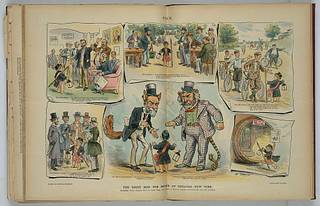
Similar
The right man for mayor of greater New York / F. Opper.
Summary
Print shows a vignette cartoon with Puck as Diogenes carrying a lantern and a lithographic pen, seeking the perfect mayor for New York City; at center Puck gets the opinion of "The Republican Machine" (Thomas C. Platt with the tail and ears of a fox) and "Tammany" Hall (Richard Croker with the tail and ears of the Tammany Tiger), and in the surrounding vignettes, he hears the opinions of "The Sunday Closers" who respect the Sabbath, "The Reformers" who seek "a man of the highest ideals ... and irreproachable character!" and have "Seth Low" at the top of their list, as well as "The Germans" and "The Bicyclers" before returning to the "Office of Puck", somewhat dismayed.
Alois Senefelder, the inventor of lithography, introduced the subject of colored lithography in 1818. Printers in other countries, such as France and England, were also started producing color prints. The first American chromolithograph—a portrait of Reverend F. W. P. Greenwood—was created by William Sharp in 1840. Chromolithographs became so popular in American culture that the era has been labeled as "chromo civilization". During the Victorian times, chromolithographs populated children's and fine arts publications, as well as advertising art, in trade cards, labels, and posters. They were also used for advertisements, popular prints, and medical or scientific books.
Tags
Date
Contributors
Source
Copyright info




![The Centennial - Bits from our artist's sketch-book. "Spanish soldier, a modern Jap., o'enry, Egypt[ian]" The Centennial - Bits from our artist's sketch-book. "Spanish soldier, a modern Jap., o'enry, Egypt[ian]"](https://cache.getarchive.net/Prod/thumb/cdn4/L3Bob3RvLzE4NzYvMDEvMDEvdGhlLWNlbnRlbm5pYWwtYml0cy1mcm9tLW91ci1hcnRpc3RzLXNrZXRjaC1ib29rLXNwYW5pc2gtc29sZGllci1hLW1vZGVybi1qYXAtNjQwLmpwZw%3D%3D/40/27/jpg)


![The city of greater New York / [...] Charles Hart. The city of greater New York / [...] Charles Hart.](https://cache.getarchive.net/Prod/thumb/cdn4/L3Bob3RvLzE5MDUvMDEvMDEvdGhlLWNpdHktb2YtZ3JlYXRlci1uZXcteW9yay1jaGFybGVzLWhhcnQtMi02NDAuanBn/40/26/jpg)


































